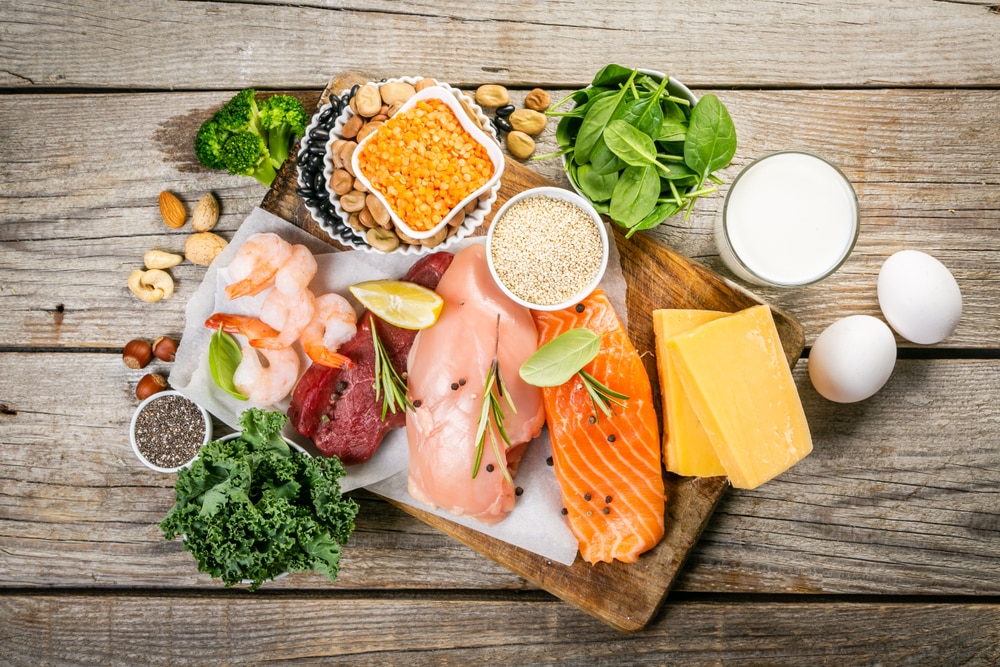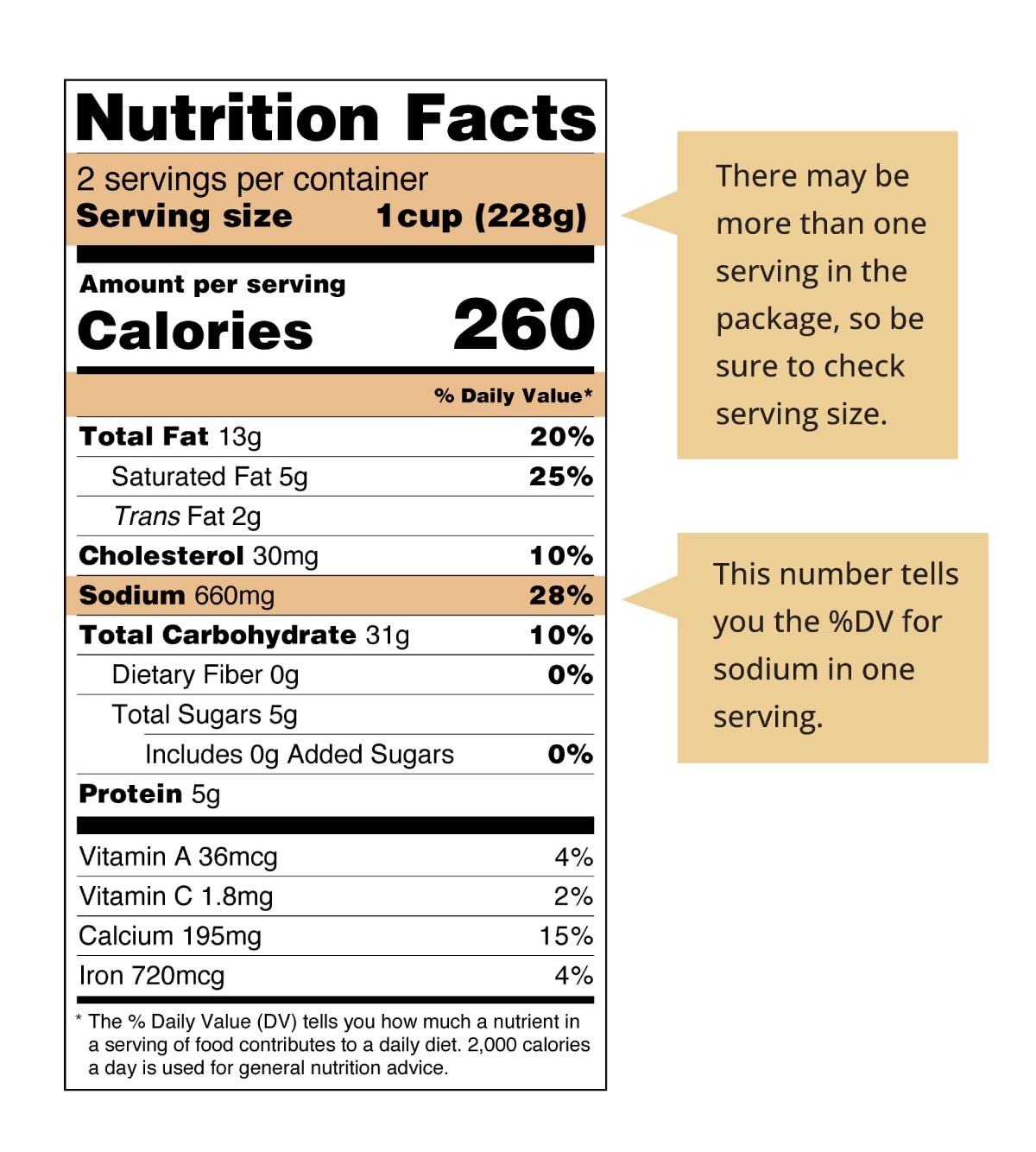Healthy Eating for Adults with Chronic Kidney Disease
In this section:
- Why is healthy eating important for adults with CKD?
- What aspects of nutrition are important for adults with CKD?
- How can I eat healthy with CKD?
- What is medical nutrition therapy?
- Clinical Trials for Healthy Eating for Adults with CKD
Why is healthy eating important for adults with CKD?
Healthy kidneys balance salts and minerals in the blood. When you have chronic kidney disease (CKD), the kidneys can’t filter your blood the way they should. What you eat and drink can help your kidneys maintain a healthy balance of salts and minerals in your body and help you feel better.
Choosing healthy foods and beverages—and avoiding foods high in sodium, potassium, and phosphorus—may prevent or delay some health problems from CKD. What you eat and drink may also affect how well your kidney disease treatments work. Understanding how different nutrients and liquids affect the body is important for people with CKD.
As CKD advances, nutritional needs change. Your health care professional may recommend you choose foods more carefully and may suggest you work with a registered dietitian, if possible, to create an eating plan for your individual needs. You can find a registered dietitian who specializes in kidney disease through the Academy of Nutrition and Dietetics online or through your health care professional.
What aspects of nutrition are important for adults with CKD?
Calories
The foods and beverages you eat and drink give your body energy. The energy is measured in calories. If you consume fewer calories than your body uses, you may lose weight. Losing too much weight can make you sicker.
Fat
Fat gives your body energy, helps control your cholesterol and blood pressure levels, and helps your body absorb vitamins. Fat also provides nutrients your body needs and is an important part of a healthy eating plan.
Everyone needs some fat in their diet, but too much fat or choosing foods higher in saturated fat or trans fat may cause buildup in your blood vessels, heart, and kidneys. People with CKD have a higher risk of developing heart and blood vessel disease and should focus on consuming healthier unsaturated fats while limiting saturated and trans fats.
Liquids
Your body needs liquids to function properly. However, people with CKD may need to limit how much liquid they consume because damaged kidneys can’t remove extra fluid. Talk with your health care professional about how much liquid you should have each day.
Phosphorus
Damaged kidneys can’t remove phosphorus from the blood as well as healthy kidneys can. Phosphorus can build up in the blood in people with CKD. Too much phosphorus in your blood can harm your blood vessels and make your bones thin, weak, and more likely to break. High levels of phosphorus in your blood can also cause itchy skin and bone and joint pain.
Potassium
CKD can make it harder for the kidneys to remove potassium from the blood, and the potassium levels in the blood can become very high. Having too little or too much potassium in your blood can cause heart and muscle problems. For this reason, it’s important to work with a dietitian or health care professional to help find the right amount of potassium for you.
Protein
Protein helps build and maintain muscle, bone, skin, connective tissue, internal organs, and blood. Protein also helps fight disease and heal wounds.
As your body uses protein, the protein breaks down into waste. Your kidneys remove this waste from the blood. Some people with CKD may need to consume moderate amounts of protein so waste doesn’t build up in the blood. However, too little protein may lead to malnutrition, a condition that occurs when your body doesn’t get enough nutrients. Work with a dietitian or health care professional to find the right balance of protein to make sure you are properly nourished without causing strain to your kidneys.
Sodium
Sodium is a mineral that helps control the amount of fluids in your body. Sodium is found in table salt and in many processed foods.
Too much sodium causes your blood to retain—or hold on to—fluids. When your body retains fluids, it can cause high blood pressure and swelling, putting stress on your kidneys and heart. Be aware of the amount of sodium in the foods and beverages you consume and work with your dietitian or health care professional to determine your sodium limit.
 Eating healthy with CKD can help your kidneys maintain a healthy balance of salts and minerals in your body and can help you feel better.
Eating healthy with CKD can help your kidneys maintain a healthy balance of salts and minerals in your body and can help you feel better.
How can I eat healthy with CKD?
There is no single meal plan for everyone with CKD. In the early stages of CKD, you may have few limits to what you can eat and drink. As your CKD advances and your nutritional needs change, you may need to make more changes to your diet.
Talk with your health care team about challenges you may have finding healthy food. A health care professional, dietitian, or social worker may be able to recommend resources that can help you. The U.S. Department of Agriculture also has a list of resources for finding and affording healthy food.
Pay attention to calories
People with CKD may avoid eating because they don’t feel hungry or because foods or beverages don’t taste the same. If you find that you don’t feel like eating, talk with a dietitian or health care professional to make sure you are getting enough calories and that the calories are from nutritious sources. Your dietitian or health care professional can help you find healthy ways to get the calories your body needs.
Choose heart-healthy foods
You may protect your heart health and lower your chance of developing heart and blood vessel disease by replacing saturated fats and trans fats in your diet with healthier unsaturated fats, which include monounsaturated fats and polyunsaturated fats.
Monounsaturated fats and polyunsaturated fats—found in foods such as canola oil, safflower oil, avocados, nuts, and seeds—are healthy alternatives to saturated fats and trans fats. Saturated fats and trans fats can raise cholesterol levels and clog blood vessels.
Saturated fats, which are found in animal products such as red meat, poultry, and butter, are usually solid at room temperature. Trans fats can be found in fast foods, fried foods, commercially produced baked goods, and other foods cooked with partially hydrogenated or hydrogenated oil or shortening.
Tips for following a heart-healthy diet include
- Choose heart-healthy foods, including plenty of fruits and vegetables.
- Grill, broil, bake, roast, air-fry, or stir-fry foods, instead of deep-frying.
- Cook with nonstick cooking spray or a small amount of olive oil instead of butter.
- Trim fat from meat and remove skin from poultry before eating.
- Limit saturated and trans fats. Look for the amount of saturated fat and trans fat on the Nutrition Facts label.
- Limit alcohol. Ask your health care professional how much alcohol is safe for you.
Talk with your dietitian or health care professional about healthy ways you can include fat in your diet.
Track your liquids
You may need to adjust how much liquid you have each day, depending on your kidney function. A dietitian or health care professional can work with you to determine how much liquid you should have each day. Contact your health care professional if you notice any swelling in your face, arms, legs, or abdomen.
Choose foods and drinks with less phosphorus
Phosphorus is found naturally in foods that are rich in protein, such as meat, dairy products, and beans. Phosphorus is also added to many foods. Phosphorus additives are the primary source of phosphorus for many people.
Tips to reduce phosphorus in your diet include
- Limit or avoid packaged and processed foods and drinks that have added phosphorus, such as deli meats, flavored drinks, and other processed foods.
- Check Nutrition Facts labels for added phosphorus. Look for “phosphorus” or words with “PHOS,” such as phosphoric acid, disodium phosphate, and monosodium phosphate on the ingredient list.
- Eat larger portions of fruits and vegetables, which are naturally low in phosphorus, and smaller portions of foods high in phosphorus.
- Keep in mind, your body absorbs more phosphorus from animal-based foods, such as meat and poultry, than from plant-based foods, such as beans and seeds.
- Some packaged meats and poultry have added phosphorus. Ask someone who works in the meat department to show you which meats do not have added phosphorus.
A health care professional can check your blood phosphorus level using a blood test. Foods and drinks with added phosphorus may cause your blood phosphorus level to go up more than foods and drinks that naturally contain phosphorus. Your dietitian or health care professional may suggest changes to what you eat and drink to help keep your phosphorus level in a healthy range.
As kidney disease advances, you may need to take a phosphate binder with meals to lower the amount of phosphorus in your blood. A phosphate binder is a medicine that acts like a sponge to soak up, or bind, phosphorus while it is in the stomach. Because it is bound, the phosphorus does not get into your blood. Instead, your body removes the phosphorus through your stool.
Choose foods that help keep your potassium level in the goal range
Your food and drink choices can help you keep your potassium level in a healthy range.
If your potassium level is high, your health care professional may recommend you
- Limit serving sizes of foods that contain potassium. Keep in mind that a large serving of a lower-potassium food may have more potassium than a small serving of a higher-potassium food.
- Use spices and herbs instead of salt substitutes, which can be high in potassium.
- Limit foods with potassium chloride on the ingredient list. Potassium chloride is sometimes used in place of salt in some packaged foods.
- Drain canned fruits and vegetables and throw out the liquid, which is often high in potassium.
- Use food preparation and cooking methods, such as boiling and leaching, that can lower the amount of potassium in certain vegetables.
- If you have diabetes and your blood glucose level—also called blood sugar level—gets low, choose apple, grape, or cranberry juice instead of other fruit juices that are higher in potassium, such as orange juice.
A health care professional can check your potassium level using a blood test. Talk with your dietitian or health care professional about ways you can adjust your food and drink choices to meet your potassium goal.
Your health care professional may suggest you take a potassium binder to lower the amount of potassium in your blood. Similar to phosphate binders, potassium binders are medicines that prevent some potassium from getting into the blood. The potassium is removed from the body through your stool.
Taking certain medicines, as well as skipping dialysis treatments, can also raise your potassium level. Your health care professional may adjust the medicines you take if your potassium level is too high. If you receive dialysis treatments, be sure to attend all dialysis sessions to help prevent potassium from building up in your blood.
 Talk with your dietitian or health care professional about changes you can make to what you eat and drink if your CKD gets worse.
Talk with your dietitian or health care professional about changes you can make to what you eat and drink if your CKD gets worse.
Choose the amount and types of protein your body needs
Protein is in many foods you eat, including foods from plants and animals. You may need to adjust the amount of protein in your diet to help keep your kidneys healthier longer. Your protein needs may also change over time.
Work with your dietitian or health care professional to find the amount and sources of
protein you should include in your diet. Your health care professional may recommend you
- limit how much meat and dairy foods you consume
- get the rest of your protein from plant-based foods
- choose lean, or low-fat, meats that also are low in phosphorus
If you don’t eat animal products, eat a variety of plant-based proteins to meet your body’s protein needs.
People with CKD who are on dialysis may need to eat more protein because the dialysis treatment removes protein from the blood. The amount of protein removed from the blood depends on the type of dialysis treatment. For example, peritoneal dialysis removes more protein than hemodialysis.
 Talk with your dietitian or health care professional about the amount and sources of protein you should include in your diet.
Talk with your dietitian or health care professional about the amount and sources of protein you should include in your diet.
Choose and prepare foods with less salt and sodium
Most Americans consume more sodium than they should. Much of this sodium comes from packaged, prepared, and restaurant foods, not from a saltshaker. Even foods that don’t taste salty can be high in sodium.
Canned foods, some frozen foods, and most processed meats contain large amounts of salt. Snack foods such as chips and crackers are also high in salt. Table salt, some seasonings, ketchup, mustard, and certain sauces such as barbecue, soy, and teriyaki sauces are high in sodium.
The 2020–2025 Dietary Guidelines for Americans recommends adults limit their sodium to no more than 2,300 milligrams per day.1 Many people with CKD need to limit their sodium even more. Your health care professional can determine your sodium limit, based on your kidney health.
Tips to reduce sodium in your diet include
- Limit the amount of prepared, packaged, and fast foods you eat.
- Choose unprocessed meats instead of processed meats.
- Check for sodium on the Nutrition Facts label of food packages. A % Daily Value of 20% or more means the food is high in sodium, and a value of 5% or less means the food is low in sodium.
- Look for foods labeled sodium free, salt free, very low sodium, low sodium, reduced or less sodium, no salt added, unsalted, or lightly salted.
- Eat more fresh, frozen, and canned fruits and vegetables without added sauce, seasonings, sodium, or salt.
- Drain and rinse canned vegetables, beans, meats, and fish with water to remove extra salt.
- Cook foods from scratch. When you prepare your own food, you control what goes into it.
- Use spices, herbs, and sodium-free seasonings in place of salt. Use alternative seasonings, such as lemon juice, herbs, and hot peppers.
Try slowly reducing the amount of sodium in your diet over time. Your taste buds will gradually adjust, and you won’t notice the change in flavor.
 Look for the serving size and sodium on the Nutrition Facts label. A label showing % Daily Value (%DV) of 5% or less per serving is considered low in sodium.
Look for the serving size and sodium on the Nutrition Facts label. A label showing % Daily Value (%DV) of 5% or less per serving is considered low in sodium.
What is medical nutrition therapy?
Medical nutrition therapy (MNT) is nutrition counseling from a registered dietitian to help meet your medical or health goals. MNT can help delay CKD progression, prevent or treat complications, and improve your quality of life.
Medicare and insurance coverage for MNT
If you are enrolled in Medicare and have CKD, Medicare will cover MNT services. You will need a written referral from a doctor, and the MNT must be provided by a registered dietitian.
If you have health insurance, check your insurance company’s website or call customer service to find out if your insurance will pay for some or all MNT. If you don’t have insurance or Medicare, ask a health care professional about the cost of a dietitian’s services. A health care professional may be able to connect you with organizations that can help cover the cost of nutrition counseling.
Clinical Trials for Healthy Eating for Adults with CKD
NIDDK conducts and supports clinical trials in many diseases and conditions, including kidney disease. The trials look to find new ways to prevent, detect, or treat disease and improve quality of life.
What are clinical trials for healthy eating for adults with CKD?
Clinical trials—and other types of clinical studies—are part of medical research and involve people like you. When you volunteer to take part in a clinical study, you help doctors and researchers learn more about disease and improve health care for people in the future.
Researchers are studying many aspects of healthy eating for adults with CKD, such as
- the impact of MNT on CKD progression
- how anti-inflammatory diets affect patients with CKD
- the relationship between protein intake and CKD progression
Find out if clinical studies are right for you.
Watch a video of NIDDK Director Dr. Griffin P. Rodgers explaining the importance of participating in clinical trials.
What clinical studies for healthy eating for adults with CKD are looking for participants?
You can find clinical studies on CKD at ClinicalTrials.gov. In addition to searching for federally funded studies, you can expand or narrow your search to include clinical studies from industry, universities, and individuals; however, the National Institutes of Health does not review these studies and cannot ensure they are safe for you. Always talk with your health care provider before you participate in a clinical study.
Reference
This content is provided as a service of the National Institute of Diabetes and Digestive and Kidney Diseases
(NIDDK), part of the National Institutes of Health. NIDDK translates and disseminates research findings to increase knowledge and understanding about health and disease among patients, health professionals, and the public. Content produced by NIDDK is carefully reviewed by NIDDK scientists and other experts.

